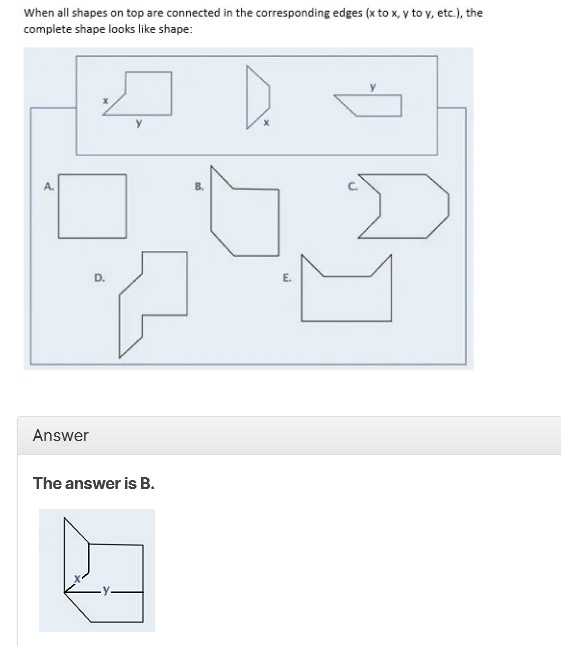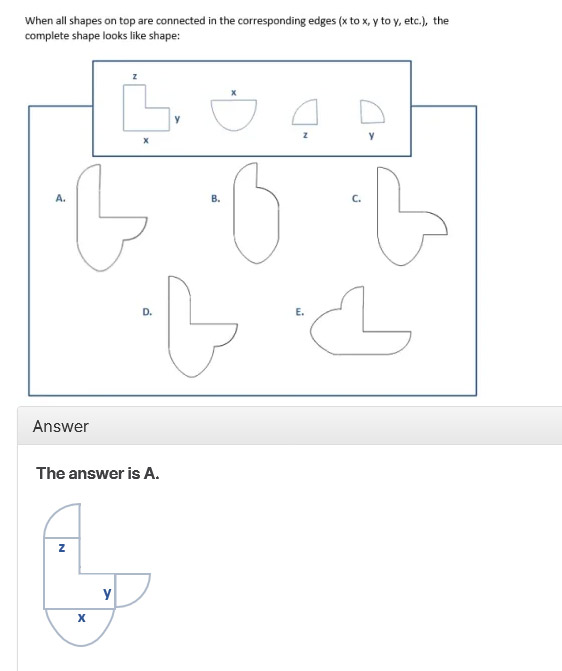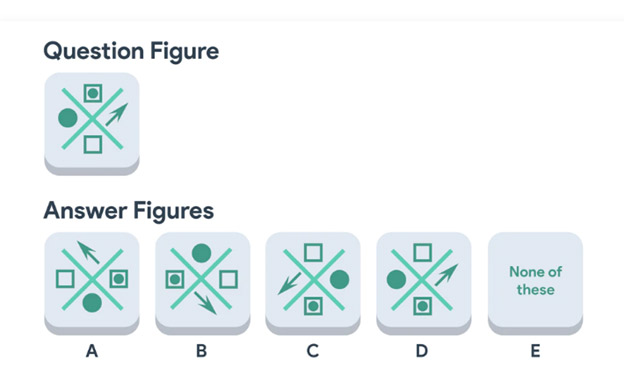
The spatial aptitude test includes knowing, reasoning, and memorizing the spatial correlations among space or objects. These skills take great effect in science, engineering, math, and technology, and display candidates’ analytical thinking skills in space and objects.
Spatial aptitude is discovered to be valuable in STEM-related careers, such as engineering, in visually imagining the motions of the components of a machine or structure that they are assigned to work with.
Spatial aptitude is required in physics for solving kinematic problems, and also in many aspects of processing numbers and calculating in math.
Spatial visualization, mental rotation, and mental folding have unique properties and are vital to different kinds of tasks encountered in professional life.
The spatial working memory supports these above-mentioned abilities and is described as the ability to temporarily store a given amount of visual-spatial memories to complete a task.
The purpose of the spatial aptitude test is to help the user identify candidates with strong skills, and it’s a great way to check analytical skills.
20 Important Facts about Spatial Aptitude Test you need to Know
Here are important facts and tips about the Spatial Aptitude Test that you need to know to enhance your ability to pass the test:
- What is Spatial Aptitude Test?
A Spatial Aptitude Test is your capacity to think about objects in their two and three-dimensional forms, view shapes from changed perspectives, and mentally work with objects presented to you.
The Spatial Aptitude Test is usually administered under a strict time limit, which means it’s vital to look for the appropriate balance between speed and accuracy.
This test is used in the armed forces to find recruits with good spatial awareness and problem-solving skills.
In the Spatial Aptitude Test, you are required to manipulate a two or three-dimensional object to solve a question using your cognitive ability.
- What does a Spatial Aptitude Test evaluate?
The Spatial Aptitude Test evaluates your ability to use objects in both two and three dimensions and then illustrate those objects from limited information.
You are required to fold, turn, and manipulate the surfaces and cubes presented to you using your mind; and also put your spatial reasoning aptitudes to the test.
- What should I expect from the Spatial Aptitude Test?
If you are applying for a job that requires high spatial reasoning abilities like engineering or architecture, you will be asked to take a Spatial Aptitude Test as part of your application.
You should be able to develop and demonstrate these skills effectively, and to do that you need to know what to expect from this spatial aptitude test.
The Spatial Aptitude Test usually comes with timed, multiple-choice answer options. You will have to follow the instructions given, which include the time limit and other important information.
- What are the types of Spatial Aptitude Tests you may come across?
Each Spatial Aptitude Test comes with a range of various questions designed to assess your ability to visualize and manipulate images in their 2D and 3D forms.
- Shape matching
The questions that come in this form ask you to analyze two groups of various shapes in diverse layouts and rotations and then match those that are the same.
You are to prove how comfortable you are with visualizing two-dimensional objects at a high speed.
The reflected images, which are typically incorrect and often included in the test to make it too challenging, are what you should watch out for.
- Group rotation
One of the things in which you will need to demonstrate your competence on the Spatial Aptitude Test is to mentally rotate shapes either in two or three dimensions.
You will be given a shape, with many possible alternative views of the same shape, and you will be asked to choose the correct one.
The shapes will often have an identifying marker, such as a square or dot. The placement of the marker is vital as it finally determines the correct answer.
- Cube views
Here, you will be required to work with three different views of a three-dimensional cube, with symbols or shapes on each face.
To evaluate how able you are at visualizing shapes from all angles, you will have to provide answers to questions about the symbols on the faces.
- Mirror images
You will be asked to find the mirror image of the two or three-dimensional shape you are provided with.
You may use logic to discount several possible answers fast and have fewer potential correct answers – that’s when the questions seem tricky.
- Combining two-dimensional shapes
You will be shown many 2D shapes that have one cut up into pieces – in this type of question.
You’ll be required to have a look at the pieces and then work out the shape the pieces fit together to make.
- Block counting
You will be presented with a series of cubes made from blocks, but you cannot see all of these blocks. You will then be required to work out how many blocks have been utilized to make the shape.
In addition, you will have to count blocks you cannot see, which is another way to test your aptitude to visualize and mentally manipulate shapes.
- Maps
The maps are designed to evaluate your ability to take instructions and follow a map. These questions are often presented in the form of a two-dimensional map or plan that you’ll be asked to navigate.
These questions may not be challenging to you if you have a good sense of direction, but ensure you are accurate even under tight time pressure.
- How to prepare for the Spatial Aptitude Test
From what we have seen so far, the Spatial Aptitude Test is not easy as there are diverse question categories to attempt, and many different skills are required to be able to self-confidently answer the questions.
One of the ways you should prepare for the Spatial Aptitude Test is to practice the test’s questions until you no longer find them difficult.
During your practice, ensure you don’t spend too much time on any question or get too anxious about the test because of its complexity.
There are practice questions and answers at the end of this article that will simulate the real experience of the Spatial Aptitude Test.
These will give you an idea of how the test questions will actually look like.
- How to build your spatial reasoning skills
For you to build your spatial reasoning ability, you need to practice and prepare. Take as many practice tests as you can to familiarize yourself with the question formats, the skills you are assessed on, and the speed at which you need to work.
Another thing you need to do is to take these tests in exam-style environments to get accustomed to catching up with the time limit of the test.
Always go back to check your answers once you’ve finished a test, and score yourself.
Give yourself credit for answers you got accurately and ensure you identify your weak points so as to give additional time to work on them.
- How is a Spatial Aptitude Test scored?
The Spatial Aptitude Test contains different questions related to dimensional judgment. Your score will be determined by the number of correct answers you get.
Your results may later be compared to the results of other test takers or the normative group.
- What does the Spatial Aptitude Test involve?
The Spatial Aptitude Test is all about questions that are based on objects in images of two or three dimensions, in which you will be asked to work out these images to figure out the answer.
Such questions could contain mirror images, two-dimensional shapes & cubes, as well as perspective-related images.
- What is the Spatial Aptitude Test used for?
The Spatial Aptitude Test is used for measuring a candidate’s ability to think about objects in various dimensions.
The questions of the Spatial Aptitude Test will assess how well you can utilize your reasoning and imagination to draw conclusions about these objects.
- Which employers use the Spatial Aptitude Test?
Employers recruiting for technical roles may use the Spatial Aptitude Test to measure your ability to think about objects in various dimensions.
These are typically design and technical jobs; for instance, architecture, engineering, surveying, and design.
The Spatial Aptitude Test questions are utilized in jobs that involve the manipulation of shapes, drawings, or plans.
Therefore, your spatial reasoning aptitude may be required in an engineering or architectural job where employers could expect you to excel in the test.
You may be asked spatial aptitude questions involving maps or street plans if you are applying for a job in the military, police, or emergency services.
You will need to prove that you understand directions as they become visible on a map and that you can use the map to plan, follow, or portray routes.
- Where can I practice the Spatial Aptitude Test?
You need to practice to achieve the greatest results in the Spatial Aptitude Test. There are many websites that render the practice free or paid.
- The Spatial Aptitude Test tips
Here are a few tips to guide you on how best to tackle the Spatial Aptitude Test questions and what to know before taking the test.
- Carry out your research
- Find alternative ways to prepare
- Consider pen and paper
- Remember the time
- Think logically
- Engage in serious practice
- Identify your strong and weak areas
- Don’t cheat
- Relax your mind
- Where is the Spatial Aptitude Test used?
The Spatial Aptitude Test is often required as part of the school admission exam for education in roles involving graphic designers, architects, pilots, air traffic controllers, etc.
Furthermore, this test is also used in the recruitment process of engineers, mechanics, architects, line assembly workers, chemists, etc.
- What can I expect from a Spatial Aptitude Practice Test Package?
If you purchase a practice test package, you need to know what you will expect from it and some of these have been listed here:
- The practice test package is appropriate for Gartner/CEB, SHL, Cubiks, Harver, Kenexa, RANRA, Saville, Talent Q, TalentLens, and Watson Glaser preparations.
- Simulating an online timed test for realistic practice
- Fully packaged with instructions and worked solutions for every question
- Including a 30-Day unlimited access
- Having questions designed by industry experts
- Used to track your progress as a personal performance system
- What is the importance of the Spatial Aptitude Test in a work scenario?
The Spatial Aptitude Test is useful in measuring a candidate’s ability to interpret two and three-dimensional shapes.
Your aptitude will be assessed by the employer to identify patterns or correlations between these shapes.
Recruiters use the Spatial Aptitude Test to assess engineering and technical job seekers. The test is also used in a wider scope in technology sectors and in the military to prove candidates’ proficiencies in interpreting their roles.
- Why do employers use the Spatial Aptitude Test?
A lot of employers, hiring managers, and university officials use the Spatial Aptitude Test as a part of their application and screening processes before taking an individual into a program or job role.
Employers have seen the importance of the Spatial Aptitude Test and use it to identify candidates with the cognitive ability to carry out the tasks of the job and to discover a candidate’s mental and cognitive skills and their ability to resolve complex issues, as well as narrow down the pool of applicants and reduce the time involved in evaluating potential employees.
An individual may be great in an interview, but poor performance in a spatial aptitude test could prove that they can’t execute the tasks of the job they are applying for.
- Why do I need to take a Spatial Aptitude Test?
You will need to know how to analyze complex data and transform an abstract concept into concrete ideas and real structures if you aspire to become an engineer, interior designer, graphic designer, or specialist in urban planning.
Acquiring the knowledge of spatial aptitude will still help you in a midst of a large applicant pool despite the fact that employers can see your resume. Spatial skills will also help you to design models and build structures.
- What are the tasks in which spatial skills may be required?
The possession of spatial skills is required in the following tasks:
- Reading and navigating maps
- Playing the video game “Tetris”
- Solving geometry problems
- Building with Legos or Magformers
- Constructing puzzles
- Packing.
- What are the related skills required in a Spatial Aptitude Test?
Since spatial reasoning is the utility of an individual’s capacity to process information and make connections between related fields, it is closely related to the following skills:
- Critical Thinking Skills
- Analytical Skills
- Problem Solving Skills
- What is the format of the Spatial Aptitude Test?
The Spatial Aptitude Test contains questions that are based on various visual challenges.
Although there is a huge range of questions that could be asked, you can expect to encounter problems requiring that you mentally manipulate objects, spot shapes from new perspectives, and identify mirror images.
It will definitely be helpful to have a grip of shapes in their two and three-dimensional forms.
Therefore, you need to practice as many similar tests as possible before your test comes to take place.
The more practice you acquire the easier you are likely to fund the test and the more relaxed you will be arranging shapes and disassembling them.
Spatial Aptitude Test Practice Questions and Answers
You will find some Spatial Aptitude Test practice questions and answers below to use in your preparation.
Bear in mind that the function of a spatial aptitude test is to assess your spatial visualization, mental folding and mental rotation abilities, as well as your spatial and visuospatial function.
The questions below are very similar to questions you are likely to meet when taking this type of test:
Question 1

Question 2

Question 3
Group Rotation Question
From the Answer Figures, which of them is a rotation of the Question Figure?

Answer: C
You should be careful to not identify reflections.
It’s the best strategy to select the most asymmetrical shape in the group – in this case, the arrow.
Afterward, decide the shapes clockwise, anticlockwise, and opposite.
It’s more logical not to use directions such as ‘right’, ‘left’, ‘above’, or ‘below’ as they are constant even when the figures are rotated.
As A, B, and D cannot be rotations of the Question Figure in the example above, it means that the white square is clockwise from the arrow.
Only C is then left as a possibility that can quickly be checked element by element.
You shouldn’t forget that no logical manipulation of the figures is required; you only show interest in identifying which of the Answer Figures is identical to the Question Figure.
Because these spatial rotation questions are very common, they are used in the tests supplied by many of the major test providers.
These questions are much easier than the three-dimensional cube questions because rotation only requires manipulation in two dimensions.
Conclusion
The Spatial Aptitude Test is fairly uncomplicated, but because the images are so alike, it can be hard to tell the difference between the answers.
You might have exceptional spatial skills and you’re perhaps remarkable at what you do, but without adequate preparation for a Spatial Aptitude Test, you might be seen to be unprepared.
You shouldn’t only take the time to practice online, but you should also take the time to review each question you complete.
Learn the shortcuts and tricks you can use for each type of question that will allow you to identify the answer as fast as possible to ace your spatial aptitude test.
>> Learn how to make a great score in Aptitude Tests, including IBEW/NJATC electrical aptitude test, situational judgement test, Kenexa, trade apprenticeship, Exxonmobil, civil service, firefighter exam, FBI test, etc. ; prepare for the test with free but effective practice tests.












